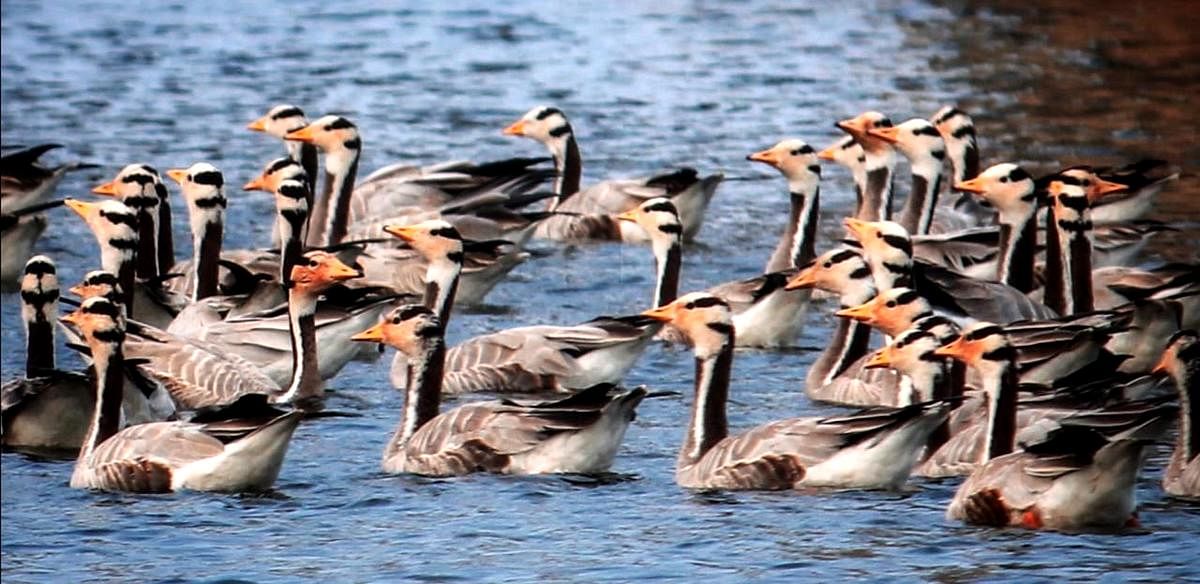
The prolonged rainy season in Karnataka over the last three years seems to have adversely impacted the migration of birds.
Overflowing lakes and disturbance in food supply chain due to continued rainfall have meant that 30 per cent-35 per cent of migratory birds, especially wetland and waders, have either postponed their arrival or changed roosting sites.
Experts and birdwatchers across the state confirmed the drastic decline in the number of migratory birds at the hotspots. However, they are divided on the exact reason. In the absence of a scientific study, they suggest that the copious rains the state received over the last three years could be one of the major reasons. Degradation of habitat and human interventions at breeding, staging or wintering sites could be the other deterrents.
The bar-headed goose, one of the most sought-after migratory birds at Magadi lake in Shirahatti taluk of Gadag district, was supposed to arrive in thousands by the first week of November. However, according to Somappa S Pashupathihal, a birdwatcher, they did not touch down at the lake in large numbers till the third week of last month.
The birds, which start their journey over the Himalayan ranges from Magnolia, refuel themselves in South Peninsular India before heading to South Africa for breeding.
“Usually, by Nov 5-7, at least 5,000 bar-headed geese would have arrived at the lake and by the end of the month, there would be 12,000 of them. But this time, the first set of five geese arrived by Nov 17 and now there are only three to five thousand of them,” he said, adding that one of the reasons could be the overflowing lake.
Karnataka is a flyway area for these migratory birds and any disturbance in the transit points will adversely impact the world's ecosystem.
Every year, 22 varieties of birds migrate to this lake between October and November from Mongolia, Australia, Tibet and other areas. This year, there is a stark decline in the numbers.
The situation is the same at several roosting sites of migratory birds in Karnataka, including the backwaters of Almatti (Bagalkot), Ankasamudra Bird Sanctuary (Ballari), Hadinaru lake (Mysuru), Attiveri Bird Sanctuary (Uttara Kannada), Karanja reservoir (Bidar), Bonal lake (Yadgir), Kodi-Bengre Beach (Udupi) and others.
Mysuru-based ornithologist Kiran Bagade says migratory birds, especially wetland birds, are very particular about the location. “With the majority of the waterbodies in the state overflowing due to prolonged rains, the food-supply chain at these lakes could have been impacted. The birds might have shifted their transit sites," he said and added that there is a need for a scientific study on this.
Vijay Itagi, a seasoned bird observer at Ankasamudra, said there have been hardly any birding activities this year. “By now, we should have recorded more than 4,000 flamingos, a good number of greater flamingos, gargini, black-tailed godwit, crested & common pochard and others. They arrived late last year also. So this year, too, we are hopeful that they will visit in large numbers,” he said.
Mysuru Regional Reviewer of e-bird portal Vijaya Lakshmi said waders and water birds like ducks and shoveler need optimum water level for feeding and resting. However, due to overflowing lakes, the entire biodiversity is affected. She says that compared to the last 10 years, they are witnessing nearly 30 per cent-35 per cent fewer migratory birds in this region.
Senior bird watcher Shivaprakash Adavanne said during a survey conducted in 2000, the state, between November and January, witnessed the arrival of nearly 1.5 lakh migratory birds. However, in the last four-five years, there has been a decline. As per the 'State of Birds' report published in 2020, the world has lost nearly 72 per cent of bird species due to human interventions.
“India, which is part of Central Asia’s flyway of northern hemisphere birds, is steadily witnessing dwindling of hotspots. Even in Karnataka, which boasted more than 40,000 waterbodies two decades ago, now has less than 20,000 lakes. Common pochard, white stork, and paddy-field warblers, which were regular winter migrants earlier have become a rare sight now," he said.
Ashwin Viswanathan, research associate at Nature Conservation Foundation, Bengaluru, said that currently there is no scientific data to prove that three years of change in rain patterns would impact the migration pattern of birds. Several institutes, including the Bombay Natural History Society (BNHS) and the Wildlife Institute of India, are coming up with satellite tracking and other scientific methods to understand the migration pattern.